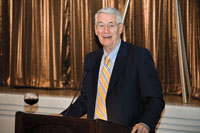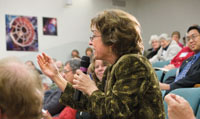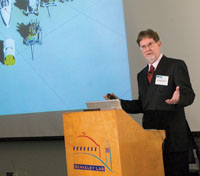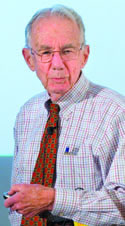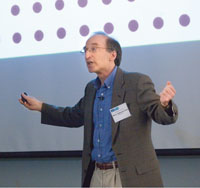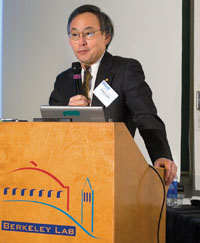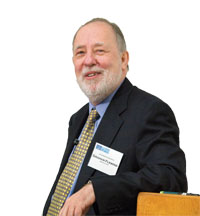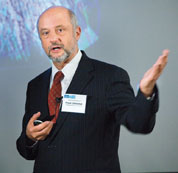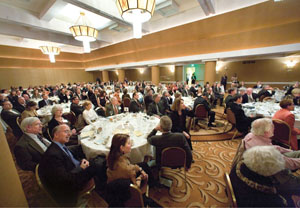

A Comet Comes to the ALS: Teams Study Organics, Minerals
Lab Achieves Safety Goals, Prepares for More Stringent Targets
A Comet Comes to the ALS: Teams Study Organics, Minerals
In January 2004 the Stardust mission flew past comet Wild 2 at over six kilometers per second, deploying a collector of wispy aerogel tiles — which slowed incoming comet particles abruptly, but gently.
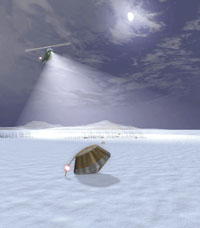 The Stardust sample return capsule reentered the atmosphere in a fiery trail across the sky, then parachuted to the Utah desert in January, 2006.
The Stardust sample return capsule reentered the atmosphere in a fiery trail across the sky, then parachuted to the Utah desert in January, 2006.
In January 2006 the sample return capsule streaked through Utah skies and parachuted safely to the desert. From Houston, NASA soon distributed a handful of the thousands of captured particles for inspection by Preliminary Exami-nation Teams (PETs), whose initial reports are published in today’s issue of Science. Samples ranged from entire particle tracks inside extracted “keystones” of aerogel to invisibly tiny microtomed slices of particle themselves.
Beamlines 1.4.3, 5.3.2, 10.3.2, and 11.0.2 at Berkeley Lab’s Advanced Light Source played leading roles in several PET reports. Among the users were Lawrence Livermore National Laboratory’s John Bradley, Anna Butterworth and Andrew Westphal of UC Berkeley’s Space Sciences Laboratory, George Cody of the Carnegie Institution of Washington, and others.
“Many different groups analyzed the same particles using many different instruments, but since infrared spectroscopy is virtually nondestructive, we were often first in line,” says Sasˇa Bajt, a Livermore physicist who worked with ALS scientist Michael Martin on infrared beamline 1.4.3.
“Working with small samples, spot size is crucial,” Martin says. “What makes our beamline distinctive is the small spot size and the very high brightness, which gives a signal-to-noise ratio a hundred or even a thousand times better than normal IR sources.”
Initially IR spectroscopy was planned only for the terminal particles, the bits at the bottom of the tracks in the aerogel. Because she was concerned about the effect that heat during impact might have had on the incoming particles, Bajt decided to scan the infrared beam along the whole length of the tracks. “When I looked at Stardust aerogels that had actually seen the comet” — as opposed to similar aerogels kept on Earth — “I noticed different types of carbon-hydrogen molecules present along some of the particle tracks.”
“Sasˇa found the track coated with different organics,” Martin says, “left behind when whatever was carrying them — ice, for example — melted and vaporized.”
Organics
Organic compounds were also identified using other techniques, including x-ray absorption near-edge structure (XANES), which plots distinctive signatures for each chemical constituent in a sample. Beamlines 5.3.2 and 11.0.2 combine XANES with scanning transmission x-ray microscopy, or STXM (pronounced sticks-um).
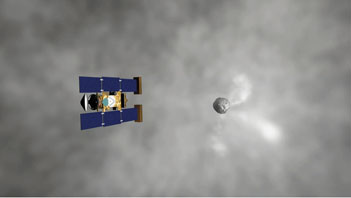 Stardust flew past Wild 2 at a difference in velocity of 6 kilometers per second (14,000 miles per hour) to collect particles outgassed by the comet.
Stardust flew past Wild 2 at a difference in velocity of 6 kilometers per second (14,000 miles per hour) to collect particles outgassed by the comet.
“Beamline 5.3.2’s STXM was designed explicitly to cover the carbon, nitrogen and oxygen edges in a single sweep,” says ALS scientist David Kilcoyne. Any compounds in Stardust samples first had to be distinguished from the background, however, especially from contaminants.
“We were told there was no carbon in the aerogel,” says Tolek Tyliszczak of the Chemical Sciences Division (CSD), who worked on the Stardust samples at beamline 11.0.2 with Mary Gilles of CSD.
“In fact there was so much carbon in the aerogel we couldn’t believe it,” says Gilles, who has previously devoted much of her research to characterizing carbon-containing aerosols in Earth’s atmosphere.
The supposedly pristine silica aerogel tiles had been contaminated during the manufacturing process or in other ways. “The wide energy range and excellent energy resolution possible with beamline 11.0.2 were a great help in separating the signals of interest from the noisy background,” Gilles says, “When we found carbon in the samples that wasn’t correlated with silicon, we knew it wasn’t coming from the aerogel.”
Minerals
Minerals were the main target of studies at beamline 10.3.2, originally developed for environmental studies. Beamline scientists Mathew Marcus and Sirine Fakra worked with what SSL’s Andrew Westphal calls “the most primitive material we’ve ever had in our hands.”
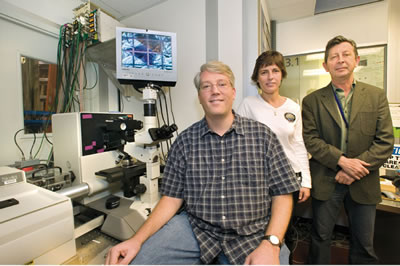 Michael Martin, Sasa Bajt, and John Bradley, members of one of several “Preliminary Examination Teams” at the ALS who contributed to the Stardust project.
Michael Martin, Sasa Bajt, and John Bradley, members of one of several “Preliminary Examination Teams” at the ALS who contributed to the Stardust project.
Says Marcus, “In x-ray fluorescence we scan a sample across a small beam spot to obtain a color-coded map of the chemistry of its constituents, according to the way they fluoresce. We use XANES to determine the atomic environment of specific elements. X-ray diffraction allows us to look at the crystalline structure of minerals.”
Fakra notes that “using micro x-ray absorption spectroscopy and diffraction techniques together, on many particles along the tracks, is a good complement to the electron microscopy work.” The combination of techniques reveals which minerals are found in the comet particles, how much of them are present in each sample, and whether and how they have been altered.
“Comets have always been cold, but some minerals can only be formed hot,” Marcus says, “What mechanisms in the early solar system formed these minerals before they aggregated in the comet?”
Questions and surprises
Hundreds of scientists and dozens of experimental techniques in facilities around the world contributed to the preliminary examination of the first Wild 2 samples, which have already produced surprises and opened new avenues for research.
“In the Wild 2 samples we found organics like those in interplanetary dust particles, and some like those in carbonaceous chondrites,” says Sasˇa Bajt. “But there were also differences in the organics from the carbonaceous chondrites ... indicating the Wild 2 particles are more primitive.” Not as primitive as the dust between the stars, however, which is also very different from Wild 2.
Not only were the particles distinctive, says Bajt, they were remarkably diverse. “If we didn’t know all these came from Wild 2, you might think they were from 20 different parent bodies.”
Many definitive results were provided by the beamlines and the researchers using them at Berkeley Lab’s Advanced Light Source. For much more on Stardust at the ALS, watch for the next issue of online Science@Berkeley Lab.
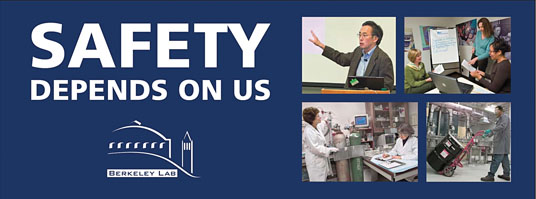
Lab Achieves Safety Goals, Prepares for More Stringent Targets
World-class research and employee safety go hand-in-hand. No one wants to get hurt, and everyone wants to go home at the end of the day safe and sound. This ultimate goal of an injury-free workplace hinges on everyone at the Lab, from senior leadership to line managers to all employees, embracing a culture of safety.
Berkeley Lab is getting there: The good news is that the Lab achieved its safety goals for FY06. The challenge, however, will be in meeting even tougher goals in FY07 — a challenge made more difficult by several recordable injuries in the past month.
“We are the only Office of Science general purpose lab that reached its FY06 goals. These are spectacular achievements,” said Lab Director Steve Chu at a Nov. 20 celebration in the cafeteria hosted by the Envi-ronment, Health & Safety (EH&S) Division. The event was convened to acknowledge the contributions of everyone at the Lab in curbing injuries in FY06.
“But the goals will get tougher next year by a factor of two,” added Chu. “We need all of your help in achieving these goals. We had a very good year, but we can’t ease up on our diligence.”
Specifically, in FY06, the Lab’s total recordable cases (TRC) goal was 1.17 cases per 200,000 hours worked. TRCs are a measure of the number of injuries that require prolonged medical attention, such as prescription drugs and physical therapy. The Lab achieved a TRC rate of 1.09. In addition, the Lab’s days away and restricted time (DART) goal was 0.5 per 200,000 hours worked. DARTs are a measure of the number of incidents that require the injured employee to miss work or switch duties. The Lab came in at 0.24. These numbers are laudable. But next year’s goals are much more stringent.
“It took tremendous awareness, commitment, and teamwork to get there,” said the Lab’s Chief Operating Officer David McGraw, who also spoke at the EH&S celebration. “The trick is going to be to continue that teamwork so we can get to that next level of rigor.”
Earlier this year, the Lab commissioned a review of its Integrated Safety Management System (ISMS) patterned after how a DOE safety audit would be conducted. This review was led by the consulting firm McCallum-Turner, with participants from other Office of Science laboratories. During a one-week visit in September, the reviewers conducted interviews, reviewed documents and observed work.
The reviewers found many positive aspects of the Lab’s ISMS. Among them, senior management has a strong sense of ownership and accountability when it comes to safety performance. A review of workspaces and interviews with staff indicated that work is typically performed safely and within established controls. Initiatives and practices to communicate and implement line management ownership of safety are being instituted. And, in general, there is a strong observed employee ethic to perform work safely.
But the reviewers also found room for improvement, which they addressed in a series of recommendations. Among them is the need to further emphasize line management accountability and responsibility for safety. In addition, the Lab should fully implement an integrated Corrective Action Management System designed to correct unsafe working conditions. And to keep unsafe conditions from leading to injuries, the Lab should increase the rigor and consistency of its work planning and control processes.
The reviewers also recommended that the Lab refine various EH&S and ISMS documents that spell out how the Lab manages and implements safety practices. These documents should provide an overarching set of safety principles and expectations for key staff and line managers, and they should establish a process for translating new requirements into practices.
An overall ISM Improvement Plan is being developed that takes into account many of the recommendations outlined in the McCallum-Turner review. The improvement plan comes at a time when the Lab needs to redouble its efforts to prevent injuries in light of the tougher FY07 goals, compounded by the fact that the Lab’s injury rate is worse now than at this time last year.
“It will be very tough to meet the FY07 goals let alone sustain our FY06 accomplishments,” says EH&S Division Director Howard Hatayama. “However difficult these goals may be to achieve, we still want people to report injuries and get help as early as possible. This is the only way to know what can be done to prevent injuries or intervene before a first aid turns into an injury.
“Now, we need systems that allow us to manage the precursors to injuries,” adds Hatayama. “The McCallum-Turner recommendations will help us sustain progress that we have already made by improving the mechanisms that we use to identify these precursors and to act on them. Everyone can help by recognizing and acting on situations and behavior that could result in an injury.”
The Lab is also working to reduce ergonomic injuries, which, in FY06, accounted for roughly half of all injuries. An ergonomic early intervention program provides supervisors with tools to use in communicating ergonomic principles, and will make it easier for employees to receive help. In addition, the Lab has hired a new Ergonomic Program Manager, and is continuing its partnership with UC San Francisco’s Ergonomics Center.
The goal of the ergonomics program — and the Lab’s other safety strategies — are to prevent injuries before they occur, which is everyone’s responsibility. Ultimately, safety is not about procedures and statistics, but about people. A safer Lab involves the participation of everyone, from senior leadership to individual employees.
Collector Hunts Down Coins, Tokens and History
During the giddy days of the California Gold Rush, the playground for pleasure seekers and those looking for luck of a different sort, was a slice of San Francisco called the Barbary Coast. Rowdy gambling halls, bars, and bordellos lined the streets of what are now Chinatown, North Beach, and the Financial District.
Today, a piece of this colorful history can be found in the tokens — issued by saloons and other businesses a century ago — in Michael Wehner’s collection. Wehner, a Computational Research Division scientist at Berkeley Lab, is the head of the San Francisco Coin Club and president-elect of the Pacific Coast Numismatic Society. Founded in 1915, the numismatic society is the oldest organization on the west coast for collectors of coins, bills, tokens, and other forms of money.
“For me, there is an interest in history. There is a challenge in finding exceptionally rare pieces,” said Wehner, whose fascination with a jar of shiny old pennies at his grandfather’s house prompted him to start collecting coins at age six. “Occasionally, I would buy something just because it’s pretty.”
Hunting for elusive collectibles isn’t the only challenge for Wehner these days. He is part of a national campaign to raise $51 million to turn a former mint, or Old Mint, in downtown San Francisco into two museums. One will feature exhibits about the city’s history, and the second one will showcase coin collections from the Gold Rush era.
As part of the fundraising work, Wehner participated in a “striking” ceremony two months ago to highlight the sales of commemorative silver and gold coins. The event, attended also by Sen. Dianne Feinstein and incoming House Speaker Nancy Pelosi, provided Wehner the opportunity to produce his own silver dollar, which features the Old Mint on one side and an eagle on the other.
Plans call for completing the preservation of the 1869 Old Mint, a Greek Revival building at Fifth and Mission Streets, by 2011. The coin museum will occupy the building’s ground floor, where the vaults once housed a third of all of the U.S. gold reserve.
“It has the perfect ambiance (for a museum) because of the big vaults and steel doors,” Wehner said. “No one had ever broken into it.”
Through collecting, Wehner has amassed great knowledge about the daily lives of San Franciscans in the 19th and early 20th century. Much of the history and many tales come from collecting tokens and medals. Issuing tokens used to be a common practice for businesses for many reasons. Bakers, for example, would sell tokens for getting 13 loaves of bread at the price of 12, the well-known baker’s dozen. Gambling dens would issue tokens of various shapes for illiterate customers who couldn’t figure out how much they had otherwise.
Some of Wehner’s favorite finds include two bronze medals made to copy the gold one that France presented to San Francisco in 1909. Made by the Paris mint, which boasted sophisticated equipment and talented artists, the medal was a good-will gesture for a city that had been devastated by the 1906 earthquake.
The medal shows a woman in a flowing gown, with the cityscape of San Francisco in the background. “They are absolutely gorgeous,” said Wehner.
His hobby reflects his intense interest in telling stories through historical data and artifacts. It is the same interest that shapes his work at the Lab. Wehner uses supercomputers at the Lab’s NERSC to create climate models, such as ones that explain the connections between extreme weather phenomena, like hurricanes, and global warming.
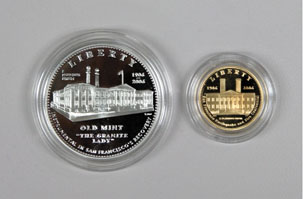
The strong link between the increasing amount of human-generated greenhouse gases such as carbon dioxide and the warming of the sea’s surface temperatures over the last century has led Wehner to predict that the world will see more intense hurricanes in the future. Hurricanes draw their strength from warm waters in parts of the Atlantic and Pacific oceans.
When Wehner isn’t at work, he can be found with a magnifying glass in his pocket at coin shows around the Bay Area, or at his home computer, searching for rare items on eBay.
He also has gotten his teenage son, Elliot, interested in the hobby. Elliot, a high school senior, collects coins from England in the Middle Ages.
“It’s been an interesting thing to do with my son,” Wehner said. “He already is an advanced collector. I didn’t do it seriously until I was an adult.”
The deadline for ordering the commemorative coins for the Old Mint project is today. They are sold at www.usmint.gov.
Those who want to learn more about the world of coin collecting can email Wehner at Mf_wehner@yahoo.com.
Putting a New Spin on It
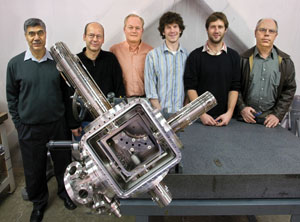
A team of researchers led by ALS scientist Zahid Hussain (left) and including Andreas Schmid, Nord Andresen, Chris Jozwiak, Jeff Graf and Gennadi Lebedev proudly display their new Time-of-Flight electron energy analyzer. This TOF device is designed to provide unprecedented energy resolution for Spin-ARPES experiments at ALS Beamline 12.0.1, shedding new light on magnetic materials.
Berkeley Lab View
Published once a month by the Communications Department for the employees and retirees of Berkeley Lab.
Reid Edwards, Public Affairs Department head
Ron Kolb, Communications Department head
EDITOR
Pamela Patterson, 486-4045, pjpatterson@lbl.gov
Associate editor
Lyn Hunter, 486-4698, lhunter@lbl.gov
STAFF WRITERS
Dan Krotz, 486-4019
Paul Preuss, 486-6249
Lynn Yarris, 486-5375
CONTRIBUTING WRITERS
Ucilia Wang, 495-2402
Allan Chen, 486-4210
David Gilbert, (925) 296-5643
DESIGN
Caitlin Youngquist, 486-4020
Creative Services Office
PHOTOGRAPHY
Roy Kaltschmidt, 486-5731
Creative Services Office
Berkeley Lab
Communications Department
MS 65, One Cyclotron Road, Berkeley CA 94720
(510) 486-5771
Fax: (510) 486-6641
Berkeley Lab is managed by the University of California for the U.S. Department of Energy.
Online Version
The full text and photographs of each edition of The View, as well as the Currents archive going back to 1994, are published online on the Berkeley Lab website under “Publications” in the A-Z Index. The site allows users to do searches of past articles.
Flea Market is now online at www.lbl.gov/fleamarket
Collaborator and Competitor
In Memoriam: Bo Bodvarsson (1952-2006)
“We come to celebrate the life of Bo Bodvarsson, because Bo lived his life 48 hours a day,” said Odette Lockwoord-Stewart, pastor of the Epworth Methodist Church, in her opening remarks at the memorial service for the director of Berkeley Lab’s Earth Sciences Division (ESD) who died unexpectedly on Nov. 29, at the age of 54.
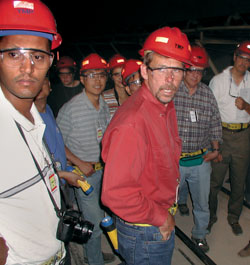 Bodvarsson conducting a tour at Yucca Mountain. Beginning in the late ’90s, as researchers were modeling fluid flow within the tunnel, Bodvarsson often gave tours to Berkeley Lab and Earth Sciences Division staff to give them a real-life perspective of the scope of the Yucca Mountain Project.
Bodvarsson conducting a tour at Yucca Mountain. Beginning in the late ’90s, as researchers were modeling fluid flow within the tunnel, Bodvarsson often gave tours to Berkeley Lab and Earth Sciences Division staff to give them a real-life perspective of the scope of the Yucca Mountain Project.
“Bo would probably be furious at what we’re doing here today, making a fuss over him, but for once he can’t have his way,” said Mary Pratt, Bodvarsson’s first wife and the mother of his oldest son, Daniel. Speaking on behalf of the family, she said, “We all loved and respected Bo, even though many of us at one time or another might have wanted to wring his neck.”
Throughout the service, which was held on Dec. 5, at the Epworth Church in Berkeley, speaker after speaker praised Gudmundur “Bo” Bodvarsson for his tremendous drive in all aspects of his life, but especially in science and sports. In science, before becoming the director of ESD in 2001, he was a noted hydrogeologist who made his mark by leading the development of a 3-D site-scale model of Yucca Mountain in Nevada, the proposed site of a permanent underground repository for high-level radioactive waste.
Said Sally Benson, who was Bodvarsson’s predecessor as ESD director, “Bo’s passion, drive and scientific leadership made every member of his Yucca Mountain Project team a star performer. That had to be one of the most challenging earth sciences problems to work on in the world, and no one did it better than Bo and the team he led. Bo challenged himself to be a great leader and in the end he always got the job done.”
In sports, Bodvarsson was renowned for his skills and competitive fire in two-man beach volleyball. He was also a long-time member of the Berkeley Fog, a top-division soccer team for over-30 players in the East Bay, where he was a powerful scorer and inspirational team leader.
“He was just a tremendous natural athlete,” said Marvin Vinik, coach of the Berkeley Fog. “Whatever sport Bo touched, he was just fabulous.”
His motivational abilities, whether in science or sports, were another recurring theme in the tributes paid to Bodvarsson. A parade of individuals described him as being a man who wanted to be the best at whatever he did and who encouraged (some said “prodded and poked”) all around him to also be the best.
Said Ernie Majer, a long-time colleague and ESD deputy director under Bodvarsson, “There was not a person I know who was a stronger advocate for his people and who fought harder for what he believed. He almost single-handedly elevated the quality of the science and work within ESD. His vitality, insight and personality will be sorely missed.”
Added Don DePaulo, another long-time ESD colleague, “When Bo was named in 2001 to be the new Earth Sciences division director, I was amazed at how he shifted from scientific warrior to scientific diplomat. It was a reflection of how competitive Bodvarsson was. He was determined to be the best ESD director ever.”
Berkeley Lab deputy director Graham Fleming called Bodvarsson “an elemental force of nature,” and “a relentless advocate for his division.” Others, like Lab Operations head, David McGraw, recalled how competitive Bo was in the annual Lab runaround, and how he once challenged members of another division to a race with ESD staffers.
Said Benson, “Bo, as a competitor and collaborator, you made all of us stronger, and you will be deeply missed.”
Bodvarsson is survived by two sons, Daniel Bodvarsson, 28, who lives in North Carolina, and Erik Ma, 7, who lives in Berkeley, and by his family in his native home of Iceland; his father Bodvar Stefansson, and brothers Stefan and Reynir. Donations in his memory may be made to The Bo Bodvarsson Memorial Fund to support young scientists at UC Berkeley in collaborative research at Berkeley Lab. Donations should be sent to the Earth Sciences Division.
A Difficult Autumn Brings to Lab Those Who CARE
Kathleen Handron has seen a lot of sadness in her 26 years with Berkeley Lab and UC Berkeley in her role as employee health services manager. But even she has to admit that the Autumn of ’06 will go down as an unusually tough one for this tight-knit community.
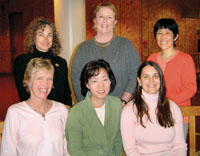 Kathleen Handron (top center) flanked by staff (bottom from left) Maureen Kelly, Sally Nho, and Gabriella Altemura, and (top from left) Ana DeNoon and Laurie Yamamoto.
Kathleen Handron (top center) flanked by staff (bottom from left) Maureen Kelly, Sally Nho, and Gabriella Altemura, and (top from left) Ana DeNoon and Laurie Yamamoto.
Of course, death never is just about one person. All who have been touched by, or affiliated with, the victim of a tragedy are themselves victims of the sometimes cruel nature of life. First, long-time physicist Mike Ronan took his own life in October in a jump from a Building 50 balcony. Then, just six weeks later, a seemingly vibrant Division Director, Bo Bodvarsson, succumbed unexpectedly to disease. And just last week, Chris Nelson of Materials Sciences, at age 46, died of an apparent heart attack.
Throw in the middle of all that an unsettling October day of concern over an unknown white powder that suddenly showed up in the Directorate’s mail, and you’ve got a challenging few months for this hillside population.
“The Lab is not a big place,” says Handron, who worked in Lab health services from 1980-94 before moving to University Health Services to head the campus’ employee assistance program. “People know each other. When something happens, people feel it. And it spreads throughout the Lab.”
That’s when the people at CARE Services — that name is not an accident, or an acronym — are called. The morning after Ronan’s body was found, Handron was on the Hill, talking with leaders and co-workers at a Physics all-hands session and then meeting individually with employees who wanted or needed to talk.
Similarly, just a day after Bodvarsson’s passing, she addressed an Earth Sciences all-hands forum and set up one-on-one office hours for most of two days. The circumstances of the deaths — and the men themselves — were very different, but their impacts on fellow workers were consistent and deep.
“We wanted to give people a chance to talk about their reactions, and let them know that there is a caring, supportive person there to help them,” she says. “We are comfort and support for them. We talk about the common reactions to loss, to trauma, and we help educate people in ways to cope with what they’re going through.”
She and her three counselors are all licensed mental health professionals, providing a wide range of personal, emotional, family and work-stress advice to staff on campus and at the Lab. They deal with hundreds of employees each year, either in person or on the phone, offering emotional triage, problem assessment and, if necessary, referrals to outside professionals.
Perhaps their most difficult assignment is grief counseling. In Mike Ronan’s case, the disturbing circumstances of the death and the sadness provided a double impact. “We emphasize to people that their reactions are not abnormal,” Handron says. “Maybe they have nightmares or think they’re going crazy. We give people a chance to talk about that and suggest ways to cope with their feelings.”
Bodvarsson, she adds, was “an extrovert, a force of nature. No one could believe he was gone. He will be leaving a big hole. And since he was very private (about his illness), it hit people very hard. People are always wondering if they could have done something (to prevent the death), and it’s important for people to articulate that as part of the recovery process.”
Physics Division Director Jim Siegrist said Handron and her staff “were a great help during a time of stress for staff in the building 50 complex. A number of our staff sought their counsel after Mike Ronan’s death, and they provided support to the entire staff at our all-hands meeting. Their professional experience provided important support in a time of need.”
The availability of CARE services is one of Lab employees’ most valued benefits. It is a no-cost source for help with issues such as relationship difficulties, loss, work stress, depression, substance abuse — in short, anything that might get in the way of working productively. One counselor devotes much of her time to elder care, an issue that grows with the number of baby boomers confronting the realities of aging parents.
Handron says if she could leave Berkeley Lab staff with two thoughts as this terrible fall comes to a close, they would be: 1) confidentiality (all contacts with counselors are confidential); and 2) “Just call.” That number is 643-7754. The web site is at www.uhs.berkeley.edu/facstaff/care/
Berkeley Lab 75th Anniversary Symposium
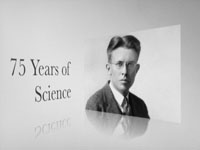
Lawrence Berkeley National Laboratory’s year-long celebration of 75 years of distinguished history concluded with an all-day academic symposium on site and a gala evening dinner at the Claremont Hotel on Nov. 14. These pages offer mere glimpses into hours rich with reminiscence, nostalgia and promise.
“Tonight we are commemorating the birth of the national laboratory system. Because, as many of you know, Berkeley Lab is the oldest of the Department of Energy’s national labs. Over the past 75 years, this Laboratory’s contributions to discovery and scientific progress have been nothing short of extraordinary. The 11 Nobel prizes awarded to Berkeley Lab scientists over the years — including, of course, George Smoot and Steve Chu — prove that this is truly sacred ground for American science and engineering.
“Ernest Lawrence was really ahead of his time when he founded this lab — in an old, neglected, wooden building — in 1931. What he established here was an institution committed to teamwork among scientists and to a multidisciplinary approach to solving complex problems — and he did so long before it was in vogue. In fact, his concept for an entirely new field — nuclear science — came from Lawrence’s belief that the research he and his colleagues were doing couldn’t be neatly defined as ‘just’ physics, or chemistry, or biology, or medicine.
“In that way, he was quite revolutionary. And, thank goodness he was. Because the men and women of Berkeley Lab have carried on his tradition of working together across disciplines — to tremendous success. Today, more and more, we are seeing the convergence of scientific fields: molecular biologists teaming up with physicists . . . geneticists capitalizing on remarkable advances in computing power . . . and physicians working with physical scientists and engineers. And this great Laboratory is a leader in encouraging these types of collaborations. Your Molecular Foundry and Helios programs are examples of the growing interface between materials science and the life sciences. And this Lab’s physicists, working with doctors in the Radiology Oncology Department of UCSF, are developing next-generation technologies for cancer treatment. That’s just to mention a few — of many — examples happening here; and these kinds of collaborations are also taking place across the national laboratory system.
“It is precisely this type of multidisciplinary work — what you might call, innovation collaboration — that I believe will help our nation confront some of the most pressing problems that it now faces.”
U.S. Secretary of Energy Samuel W. Bodman
75th Anniversary gala, Nov. 14“If I had to sum up the 75-year history of the Lawrence Berkeley National Laboratory, I would say that the people who made it a success – from Ernest Lawrence at the start to Chuck Shank and Steve Chu in modern times — shared an idiosyncrasy that is uniquely Californian: None of them understood the meaning of the word ‘impossible.’
“It seemed impossible to build a new lab for a new kind of science during the Great Depression. But Ernest Lawrence didn’t understand that. So he found the resources. He recruited a brilliant team. He revolutionized physics. And he helped establish the University of California as an intellectual powerhouse. His successors have carried on that tradition of extraordinary achievement… as Chuck did in the launch of the Advanced Light Source… and as Steve is doing today in the pursuit of the Helios project.”
University of California President Robert Dynes
75th Anniversary gala
“The University of California at Berkeley would not be the preeminent university that it is without the Berkeley Lab. We are synergistically linked, each one contributing to the strength of the other.”
Robert Birgeneau,
Chancellor, UC Berkeley
75th Anniversary gala
Why does it make so much sense to do cell and cancer biology at a national lab? Complexity. To understand how at any given time your billions of cells know what to do and why it will take multidisciplinary interaction between biologists, chemists, physicists, engineers, bioengineers, theoretical biologists and all those who think outside the box."
Mina Bissell,
Distinguished Scientist
75th Symposium
“I think it (the 75th anniversary) is quite amazing. (When I was Director) we celebrated the 45th, 30 years ago. We were concerned that some of the ‘giants’ wouldn’t live another five years. We never thought about the 75th, since it would be unlikely we would be here. But it all brings back pleasant memories. They were very good times.”
Andrew Sessler
Lab Director, 1973-80
75th Symposium, Nov. 14
“The management of this Labor-atory has been very broad-minded, supporting projects from a wide range of interests. This broad-mindedness and liberalness has spawned an enormous number of things.”
Donald Glaser,
1960 Nobel Prize winner
75th Symposium
“Berkeley Lab provided the kind of environment that allowed this (his studies of the cosmic microwave background from the birth of the universe) to go forward. When I came to Berkeley, and I saw the Lab, my eyes were opened. It was a place where I was not only given the freedom and the resources to do the research, but shown the style of how to do the research. It was: Pick out the best science you can do and do it. That was so liberating.”
George Smoot,
2006 Nobel Prizewinner
75th Anniversary gala
“What a wonderful day this is. It has been dominated by older heroes, but it is wonderful to see new heroes in the making. I’m thrilled at what a wonderful dynamic the Lab has become. I’ve very happy.”
Art Rosenfeld,
Energy Pioneer
75th Symposium
“Anyone know when the first computer arrived at Berkeley Lab? It was installed in 1956 or ’57, and was used by Luis Alvarez. He showed how computers would make data analysis possible. That was very visionary. It had about 1,000 to 2,000 words of storage capacity. An abacus could outperform it.
“The future for computing is bright. It will have a profound impact on science and will be built into the very fabric of science. We (the Lab) have all the right pieces in place to change the face of science over the next two decades.”
Horst Simon,
Associate Lab Director
75th Symposium
“This (the symposium) makes you feel really proud to be at LBNL. (When I came to the Lab in 1983) the feel of science was here. The real ‘can-do’ attitude really got instilled here.”
Saul Perlmutter,
Astrophysicist
75th Symposium
“The Lab has been a succession of giants. Andy Sessler was one of my heroes here, because he did something heroic — he took a physics lab pure in body and soul, took the intellect of science and made it into something important for the world. It was the beginning of the multi-program lab.
“What were my greatest accomplishments? On top of the list were the people who surrounded me, (people like) Pier Oddone, who played an important role in the growing breadth of science. And second, the Division Directors, like Mina (Bissell), who created modern biology at this Lab. But most important, (the fact that I could) make this lab exciting enough to attract my colleague and friend, Steve Chu, one of the greatest scientists of our time, to the lead the Lab.”
Charles Shank
Lab Director, 1989-2004
75th Symposium
Top, L-R: Steve Chu, Graham Fleming, Pier Oddone. Bottom: the dinner.
Berkeley Lab Science Roundup
Shrinking Nanotubes, Gift-Wrapped Drugs, a Hydrogen Sponge, and the Elusive Pseudogap
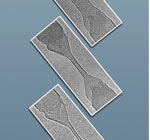
Sequential images show the central part of a carbon nanotube shrinking as it is heated under the electron microscope’s beam. The images are about 80 nanometers wide (about 80 billionths of a meter).
Alex Zettl, Tom Yuzvinsky, William Mickelson, Saul Aloni, Gavi Begtrup, and Andras Kis discovered that heating can cause carbon nanotubes to shrink smoothly to virtually zero diameter, while electrical resistance falls precipitously. Research published online in Nano Letters November 2 showed the process can be halted at any diameter.
Jean Fréchet and UCSF colleague Frank Szoka led a team including Steven Guillaudeu who demonstrated that wrapping anticancer drugs in dendrimers could be a lot less toxic than the same drug delivered straight. Their research appeared online October 30 in Proceedings of the National Academy of Sciences.
At the International Congress of Nanotechnology that opened October 30, Fréchet and Frantisek Svek announced they’d set a new record for absorbing hydrogen in nanoporous styrene. At room temperature the cheap new material is 1.6 percent hydrogen by mass, well on the way to DOE’s fuel storage goal of 6 percent.
Alexei Fedorov was on a team led by Brookhaven’s Tonica Valla that solved one mystery of the pseudogap, created in high-temperature superconducting materials when electrons “preform” pairs above the transition temperature. How do they do that? That part is still a mystery. The research appeared in Science November 17.
Selenium Bad and Good, Anthrax Unmasked, Proteins in the Worm, Engineering Fruit Flies, and Building the Cell Nucleus
Selenium is bad for animals but good for plants like the Prince’s Plume that use it to poison sucking insects. The diamond-back moth thrives on selenium, which could be a good thing for controlling Prince’s Plume where the weed poisons livestock. Matthew Marcus and Sirine Fakra contributed to research led by Elizabeth Pilon-Smits of Colorado State University, published November 20 in Current Biology.
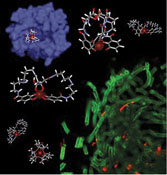
Anthrax bacteria (green, lower right) secrete two kinds of iron-scavenging molecules. One is intercepted by the body’s defenses but the other slips through.
Anthrax uses two iron scavenging proteins to evade the human body’s bacteria defenses, which use only one. An analysis published by Ken Raymond and a team including Rebecca Abergel, Trisha Hoette, and colleagues from the University of Mississippi and the Fred Hutchinson Cancer Center in Seattle in the November 28 PNAS should help devise counterdefenses.
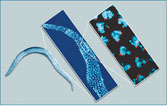
The millimeter-long, transparent nematode C. elegans is ideal for observing the development of the worm's sex cells, including the proteins that bring chromosomal Pairing Centers together.
Abby Dernburg and Carolyn Phillips have identified the genes and proteins that control how chromosomes in the nematode C. elegans pair for accurate copying during sex-cell division. The discovery of the worm’s zinc-finger proteins, published in the December issue of Developmental Cell, is an insight into the evolution of sex in higher animals.
Roger Hoskins is co-PI of the Drosophila Genome Disruption Center led by Hugo Bellen of the Baylor College of Medicine, which recently created P[acman], a new technology for putting gene modifications (including off switches) in the fruit fly genome right where researchers want them. The work was published online in Science Express November 30.

A normal Drosophila cell nucleus (left) contains just one well-formed nucleolus. Cell nuclei that are mutants in an important regulatory pathway (center and right) exhibit many malformed nucleoli.
Gary Karpen and Jamy Peng uncovered two pathways that regulate Drosophila heterochromatin, chromosomal stuff that contains mostly noncoding DNA. The molecular mechanisms control the architecture of the nucleolus, which manufactures vital ribosomes. Their work appeared December 11 in Nature Cell Biology.
Two Berkeley Lab Scientists Elected to AAAS Fellowship
Steven Louie, a theoretical physicist with the Materials Sciences Division, and Stuart Freedman, a nuclear physicist with the Nuclear Science Division, have been elected to the prestigious position of “Fellow” by the American Association for the Advancement of Science (AAAS). They will be among the 449 new Fellows to be inducted on Feb. 17, 2007, during the AAAS annual meeting in San Francisco.
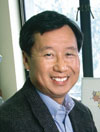 Louie
Louie
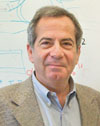 Freedman
Freedman
The tradition of AAAS Fellows began in 1874, with members being elected to the position by their peers in any of 24 sections. Fellows are recognized for meritorious efforts to advance science or its applications. AAAS itself was founded in 1848 and is the world’s largest general scientific society.
Louie, who holds a joint appointment with Berkeley Lab and UC Berkeley, is director of the Theory of Nanostructured Materials Facility at the Molecular Foundry, and a leading authority on creating atom-by-atom models of theoretical materials from “first principles” calculations. He was elected as a AAAS Fellow for his “fundamental contributions to the theory of solids and nanostructures, including his pioneering development of first-principles study of excited-state properties and prediction of new materials.”
Said Louie in response to his election, “I am delighted and honored being elected Fellow of the AAAS. To be recognized by one’s peers is especially gratifying as a scientist. I feel very fortunate to be here at Berkeley, with so many great colleagues and continued support from Berkeley Lab and the UC Berkeley campus.”
Freedman, who also holds joint appointments with Berkeley Lab and UC Berkeley, is the co-spokesperson for the U.S. team of researchers at KamLAND, an underground neutrino detector in central Japan. An experimentalist, the thrust of his research has focused on precision measurements in atoms and nuclei to answer fundamental questions in particle physics.
He was elected as a AAAS Fellow for his “important contributions to our understanding of fundamental symmetries in atomic and nuclear physics, and to an understanding of neutrinos and their weak interaction.”
Said Freedman in response to his election, “I am delighted to be elected to the AAAS Fellowship. I take it as recognition of my enthusiastic support of the scientific enterprise.”
In Memoriam
NCEM’s Chris Nelson: ‘The Kind of Person Who Makes Berkeley Lab Great’
Edmund Christian “Chris” Nelson, one of the most experienced microscopists at Berkeley Lab’s National Center for Electron Microscopy (NCEM), passed away unexpectedly Thursday night of an apparent heart attack. He was 46.
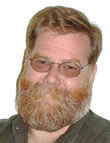
Nelson joined NCEM in 1984, shortly after the center was first established as a national user facility. His professional growth paralleled that of the facility. From a junior technician, he developed into the most accomplished operator of the Atomic Resolution Microscope and the most proficient pilot of the One- Angstrom Microscope.
He was about to take on responsibility for NCEM’s world-leading Transmission Electron Aberration-Corrected Microscope (TEAM) upon its installation next year. Over the past two decades, he collaborated with hundreds of scientists and trained scores of users and visitors of the facility. His contribution to the microscopy community was recently recognized with the prestigious Outstanding Technologist Award of the Microscopy Society of America.
His death is a major loss to the facility and the Lab, said NCEM Director Uli Dahmen. “We are devastated by the untimely loss of Chris Nelson,” he said. “Chris was the backbone of NCEM, the kind of person who makes Berkeley Lab great. He was an awesome microscopist who understood advanced electron microscopes like a test pilot understands a jet plane.
“But he also understood people, and the combination of his reassuring personality with his superb technical skill made a key contribution to the facility. His death is a tremendous blow to NCEM and its user base. We are deeply saddened by the loss of a great colleague and friend.”
Chris Nelson is survived by a brother, Richard, of Oregon, and a sister, Kim, from the state of Washington.
People, Awards, and Honors
Engineers Honor Leemans on Accelerators

Berkeley Lab accelerator scientist Wim Leemans has been elevated to the position of Fellow of the Institute of Electrical and Electronics Engineers, among the most prestigious of IEEE honors. Leemans was cited “for contributions to the field of advanced accelerators, in particular laser-plasma acceleration of electrons.”
LDRD FY2008 Call for Proposals
The FY2008 Call for Proposals has been issued for the Laboratory Directed Research and Development (LDRD) program, which provides support for projects in forefront areas of science that can advance Berkeley Lab’s R&D competencies and open up new directions and capabilities.
The Call for Proposals has been distributed to Division Directors and business managers. Principal investigators must submit proposals to division directors by Wednesday, March 14.
After an internal divisional review and evaluation, Division Directors will forward the proposals with their rankings to the Director’s office in anticipation of the proposal reviews. As part of the proposal reviews, Division Directors will defend their rankings to review committees comprised of the Director, Deputy Director, Associate Laboratory Directors, and other Division Directors.
Similar to prior years, for FY2008 a subset of proposals will be reviewed by a broader representation of all senior managers in a “Laboratory-wide” proposal review. These proposals generally are more cross-divisional and larger scale, and intended to initiate and/or develop major new strategic directions. If Principal Investigators and their Division Director anticipate the proposal would be appropriate for this forum, the scientist(s) must also discuss the proposal with the area’s Associate Laboratory Director (ALD) prior to submission. Final selection of proposals for this review will be made by the Deputy Director in consultation with the ALDs.
The complete call, schedule, guidance, and forms are available for downloading off the Lab home page under the heading “Publications,” then LDRD, or directly at http://www.lbl.gov/DIR/LDRD/
